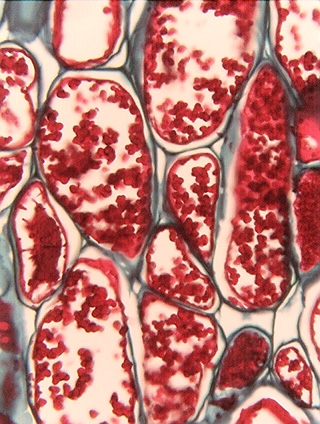 Fig.
3.6-5. Root cells in Clusia. The red-stained particles here
are tannins, which are an extremely common
storage product for many plants. Storage products such as starch, protein or
water are stored temporarily and then are mobilized and used by the plant for
its further growth and development. Tannins, in contrast, deter animals from
eating the plant material – tannins react with the proteins in the animals’
digestive system, denaturing (tanning) them and thus either killing the animal
or encouraging it try eating some other plant. In some plant species, tannins
are present as a uniform, smooth substance rather than the particles seen here.
As the samples were dehydrated with alcohol, the protoplasts shrank slightly,
leaving a white space between the tannin particles and the wall. The space is
thus an artifact, but it gives us a good view of the thin primary wall. Small
intercellular spaces are present between cells, but no organelles can be
distinguished among the tannin particles – these cells might in fact have died
even before the sample was collected. Tannic acid, used to tan leather, is
extracted from cells like this in insect galls on oaks.
Fig.
3.6-5. Root cells in Clusia. The red-stained particles here
are tannins, which are an extremely common
storage product for many plants. Storage products such as starch, protein or
water are stored temporarily and then are mobilized and used by the plant for
its further growth and development. Tannins, in contrast, deter animals from
eating the plant material – tannins react with the proteins in the animals’
digestive system, denaturing (tanning) them and thus either killing the animal
or encouraging it try eating some other plant. In some plant species, tannins
are present as a uniform, smooth substance rather than the particles seen here.
As the samples were dehydrated with alcohol, the protoplasts shrank slightly,
leaving a white space between the tannin particles and the wall. The space is
thus an artifact, but it gives us a good view of the thin primary wall. Small
intercellular spaces are present between cells, but no organelles can be
distinguished among the tannin particles – these cells might in fact have died
even before the sample was collected. Tannic acid, used to tan leather, is
extracted from cells like this in insect galls on oaks.